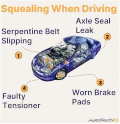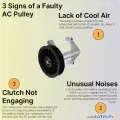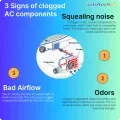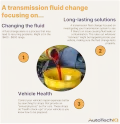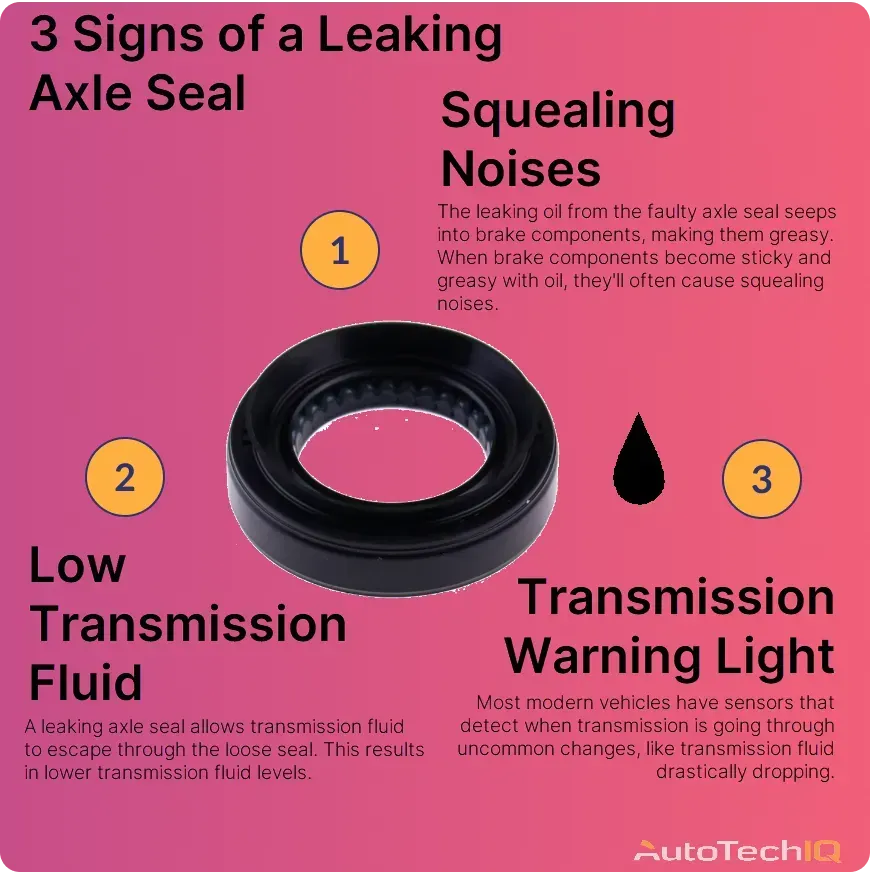
The main signs of an axle seal leaking are a squealing noise and a burning oil smell. The axle seal prevents transmission or gear fluid from escaping. However, when it’s loose or cracked, the fluid escapes and seeps into the braking system. In the braking system, the fluid causes brake components to wear out and produce a squealing noise; it can also seep into overheating components and burn, producing a burning oil smell.
-
Positioning: The axle seal is located where the axle shaft meets the differential or the transmission, under the vehicle. In rear-wheel-drive vehicles, you'll typically find the axle seal at the ends of the axle tubes near the wheels. This seal can leak due to age, improper axle installation, a faulty axle nut, etc.
When the vehicle runs, it’ll heat internal components, and a loose axle seal allows transmission fluid to escape and fall into hot car parts. Consequently, the fluid burns and releases a smell.
-
Safety: A leaky axle seal causes the vehicle to lose transmission fluid. If the fluid gets too low, the transmission can develop issues and start slipping. Additionally, the fluid can seep into the brake system, causing braking components to become greasy and sticky. This greasiness makes brake pads, calipers, and rotors become partially applied, resulting in deterioration and squealing noises.

A squealing noise
The squealing noise results from the vehicle’s brake components becoming sticky and greasy. This stickiness causes brake components to become partially applied as the vehicle drives. This constant friction deteriorates the brake pads, which then emit squealing noises.
Acting early is crucial since brake pads can only deteriorate so much until they start damaging other brake components and result in critical braking malfunction.
Burning oil smell
A loose axle seal allows transmission and differential oil to leak out of the system and seep into various car parts. This means the fluid can fall into hot car parts as the vehicle drives, causing a burning oil smell.
The burning oil smell can be concerning since it means the fluid is falling somewhere it’s not supposed to in the car. A leaking seal can result in different types of problems and even toxic or flammable accidents.
Other common signs
Here are other common signs that some of your vehicle’s hoses might be melting/burning:
-
Fluid under the vehicle
-
Low gear oil or transmission fluid
-
Noisy differential or transmission
-
Grease or oil on the inside of the wheels
-
Vibration while driving
Possible fixes
-
Axle seal replacement: Replacing with a new seal can be the only fix you need. This is common if the issue hasn't progressed and affected other components.
-
Brake caliper replacement: You might have to replace some brake components, like the brake caliper. This might be one of the recommended fixes for when the fluid leaking from the seal seeped into the brake components.
-
Transmission pan replacement: An axle seal leak can lead to a transmission pan replacement if the leaking fluid contaminates the area around the transmission pan, causing components like the gasket to deteriorate.
-
Transmission cooler replacement: An axle seal leak can indirectly lead to the need for a transmission cooler replacement if the leaking fluid results in low transmission fluid levels, causing the transmission to overheat.
-
Wheel bearing replacement: The leaking fluid from the faulty axle seal can fall into brake components and consequently surround the wheels. The wheel bearing can become greasy and sticky with the leaky fluid, resulting in further damage, overheating, and wear. A new bearing might be needed.
Frequently Asked Questions
How often should axle seals be replaced?
Axle seals don't have a specific replacement interval like other car parts, as their lifespan can vary based on factors such as driving conditions, vehicle usage, and the quality of the seal. Typically, axle seals should be inspected regularly during routine maintenance, such as when changing the differential or transmission fluid. If a seal shows signs of wear, damage, or leakage, it should be replaced immediately. In general, axle seals can last for many years and tens of thousands of miles, but they should be replaced whenever oil drops off them or when the axle or related components are being serviced.
Can I drive my car with a leaky axle seal?
While it's possible to drive with a leaky axle seal, it's not recommended. A leaking axle seal can lead to a constant low fluid level, which is crucial for differential or transmission needs, like lubrication and cooling. Driving with low fluid levels can cause these components to overheat, wear out prematurely, or even fail, leading to expensive repairs. Additionally, leaking fluid can contaminate the brake fluid, the differential fluid, the wheel hub assembly, etc. It's best to address a leaky axle seal as soon as possible to avoid further damage and ensure safe driving conditions.
How serious is an axle seal leak?
An axle seal leak is a serious issue that should not be ignored. While the leak itself might start small, it can lead to significant problems if left untreated. The loss of gear oil or transmission fluid from a leaking axle seal can cause insufficient lubrication and cooling of the differential or transmission, leading to overheating, increased wear, and potential failure of these critical components. This can result in costly repairs or even a complete breakdown of the vehicle. Additionally, the leaking fluid can contaminate other parts, like the brakes, compromising vehicle safety. Addressing an axle seal leak promptly is essential to avoid these risks.
